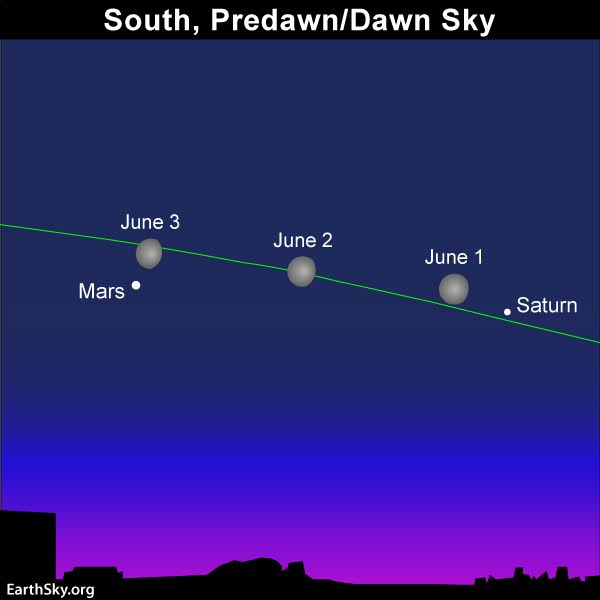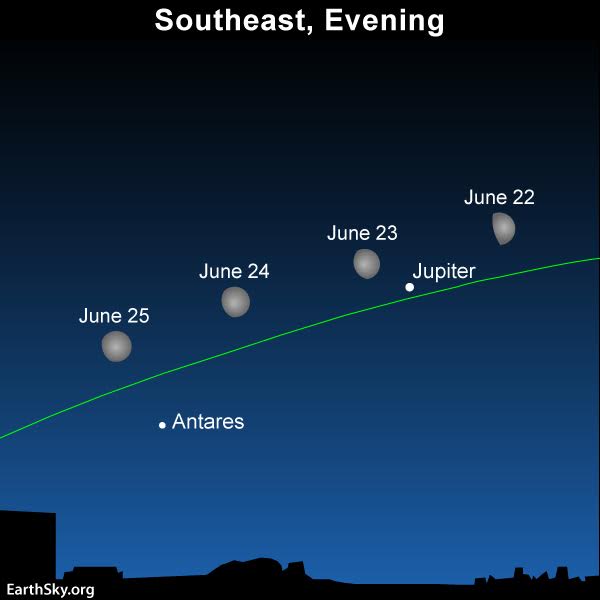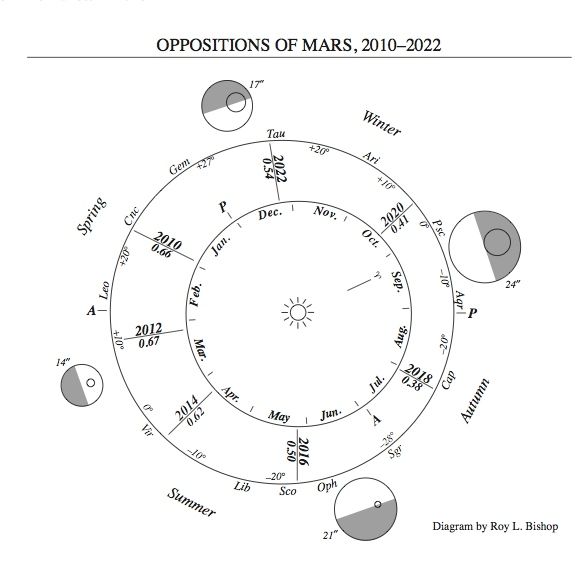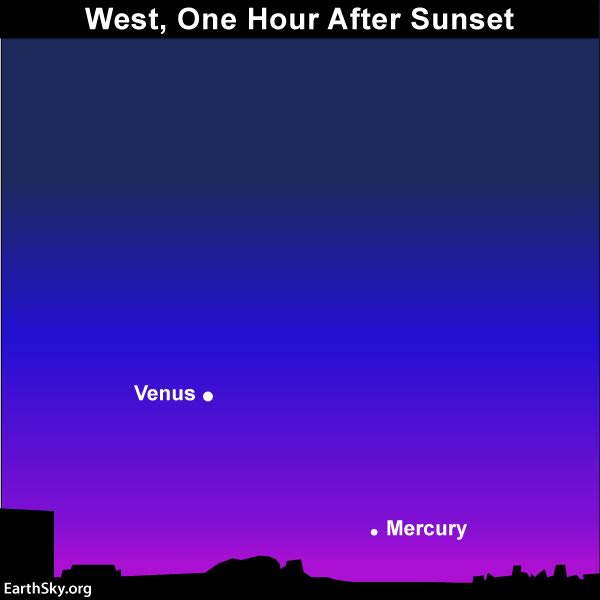
Watch for the moon to sweep past both Saturn and Mars in early June 2018. Read more.
Click the name of a planet to learn more about its visibility in June 2018: Venus, Jupiter, Saturn, Mars and Mercury
Help EarthSky keep going! Please donate what you can to our annual crowd-funding campaign.

The waxing crescent moon will sweep by the planets Mercury and Venus from June 14 to 16. Read more.
Venus is the brightest planet, and it’s very prominent this month in the west after sunset. Throughout June, Venus appears as a dazzling evening “star.” Look for Venus to adorn the western evening sky until October 2018.
At mid-northern latitudes, Venus attains its highest altitude as the evening “star” in June 2018. That’s in spite of the fact that Venus’ greatest elongation (maximum angular distance from the setting sun) doesn’t occur until August 17, 2018. At mid-northern latitudes, Venus sets roughly 2 1/2 hours after the sun throughout the month.
In the Southern Hemisphere, Venus’ altitude will increase day by day all month long. At temperate latitudes in the Southern Hemisphere, Venus sets about 2 1/2 hours after the sun in early June. By the month’s end, that’ll increase to about 3 hours after sunset.
Circle June 15 and 16 on your calendar. That’s when the young moon will be sweeping past Venus in the evening sky. The western twilight will make the pairing all the more picturesque.

The moon appears much larger on our sky chart than it does in the real sky. Look for the moon close to Jupiter on June 22 and 23, and to the north of the star Antares on June 25. Read more.
Jupiter is still bright and beautiful throughout June 2018. Our planet Earth passed between the sun and Jupiter – bringing the planet to opposition – on the night of May 8-9, 2018. From anywhere around the globe, you’ll still find Jupiter in the eastern or southeastern part of the sky at nightfall – highest in the sky at early-to-mid evening – and setting in the west before dawn. Jupiter is brighter than any star, but it’s not brighter than Venus, which is in the west after sunset, while Jupiter is in the eastern half of sky.
Jupiter shines in front of the constellation Libra the Scales until November 2018. Look for Libra’s brightest stars near Jupiter, Zubenelgenubi and Zubeneschamali (both star names are pronounced with the same rhythm as Obi-Wan Kenobi, of “Star Wars”).

In any year, you can find the constellation Libra between the star Antares (to the east of Libra) and the star Spica (to the west of Libra, outside the chart). But in 2018, the planet Jupiter acts as your guide “star” to this fairly faint constellation. You’ll find Jupiter and the constellation Libra in your southern sky around midnight in May 2018, and around mid-evening in June 2018.
If you aim binoculars at Zubenelgenubi, you’ll see this star as two stars. Zubeneschamali, meanwhile, is said to appear green in color, although, astronomers say, stars can’t look green.
Let the moon guide your eye to Jupiter on the evenings of June 22 and 23.

Watch for the bright moon to swing near Saturn and then Mars from June 27-30, 2018 . Read more.
Saturn and Mars rise into the southeast sky after nightfall in early June. At the beginning of the month, Saturn rises at about the time that Venus sets; and by the month’s end, it’s Mars that rises when Venus sets. Throughout the month, Mars rises about two hours after Saturn does.
In early June, at mid-northern latitudes (U.S., Europe, Japan), Saturn rises about 9 to 10 p.m. local time (10 to 11 p.m. local daylight saving time) and Mars follows Saturn into the sky roughly two hours later. Near the month’s end, when Saturn reaches opposition on June 27, Saturn rises around sunset and Mars rises around nightfall (approximately two hours after sunset).
In early June at temperate latitudes in the Southern Hemisphere (South Africa, southern Australia, New Zealand), Saturn rises around 7 p.m. local time and Mars comes up about two hours later, around 9 p.m. local time. Near the end of the month, around the time of Saturn’s opposition, Saturn rises around sunset and Mars follows Saturn into the sky roughly two hours later.
Click here for recommended sky almanacs; they can give you the rising times of the planets.
The predawn hours before sunrise, especially in the first half of the month, might offer a better view of Saturn and Mars, as these worlds are seen much higher up in the sky than they are before midnight.
You can tell Mars from Saturn because Mars has a reddish color. Saturn looks golden. Binoculars show their colors better than the eye alone.
Early in the month, on the mornings of June 1-3, the moon is sweeping past these planets, as shown on the chart below. Then, again, at the end of the month, watch for the moon to again sweep by Saturn and Mars from June 27-29, as shown below as well.

Watch for the moon to sweep past both Saturn and Mars in early June 2018. Read more.

Watch for the bright moon to swing near Saturn and then Mars from June 27-30, 2018 . Read more.
At present, both Saturn and Mars shine more brilliantly than a 1st-magnitude star. However, Mars is brighter than Saturn. Saturn’s brilliance will increase until it peaks at its June 27 opposition, and Mars’ brilliance will also increase until it peaks at its July 27 opposition.
But Saturn’s brightness increase will be subtle, while Mars’ will be dramatic! At the beginning of June, Mars is about 3 1/2 times brighter than Saturn, whereas by the month’s end, Mars will be some 7 1/2 times brighter than the ringed planet.
It’s not often that Mars outshines Jupiter, normally the fourth-brightest celestial object to light up the sky, after the sun, moon and Venus. But, for a couple of months in 2018, Mars will outshine Jupiter from about July 7 to September 7, 2018.
Remember Mars’ historically close opposition of August 28, 2003? That year, it was closer and brighter than it had been in some 60,000 years. This upcoming July opposition will be the best since 2003.
Read more: Mars brighter in 2018 than since 2003
Click here for more about close and far Mars oppositions

Diagram by Roy L. Bishop. Copyright Royal Astronomical Society of Canada. Used with permission. Visit the RASC estore to purchase the Observers Handbook, a necessary tool for all skywatchers. Read more about this image.
Mercury, the innermost planet of the solar system, moves out of the morning sky and into the evening sky on June 6, 2018. However, this world probably won’t first become visible in the western evening twilight until mid-month or so, when the slim waxing crescent moon couples up with Mercury on or near June 14. More realistically, you may have till wait till the month’s end to view Mercury, when this world sets about 1 1/2 hours after sunset at mid-northern latitudes (and about 1 3/4 hours after the sun at temperate latitudes in the Southern Hemisphere).
Mercury will reach its greatest elongation from the sun on July 12, 2018, and its reign as the evening “star” will extend all the way through July 2018. If you miss seeing the moon with Mercury in mid-June, try again in mid-July.

Your chances of spotting Mercury in the western evening twilight will be much better by late June and early July 2018. Read more.
What do we mean by bright planet? By bright planet, we mean any solar system planet that is easily visible without an optical aid and that has been watched by our ancestors since time immemorial. In their outward order from the sun, the five bright planets are Mercury, Venus, Mars, Jupiter and Saturn. These planets actually do appear bright in our sky. They are typically as bright as – or brighter than – the brightest stars. Plus, these relatively nearby worlds tend to shine with a steadier light than the distant, twinkling stars. You can spot them, and come to know them as faithful friends, if you try.
Bottom line: In June 2018, at evening dusk, Venus appears in the west whereas Jupiter lords over in the eastern half of sky. In early June, Saturn rises as Venus sets; and by late June, it’ll be Mars that rises as Venus sets. Mercury may be seen in the evening sky, starting around mid-June 2018. Click here for recommended almanacs; they can help you know when the planets rise, transit and set in your sky.
Don’t miss anything. Subscribe to EarthSky News by email
Enjoy knowing where to look in the night sky? Please donate to help EarthSky keep going.
Get your EarthSky 2018 lunar calendar now, while they last.
Visit EarthSky’s Best Places to Stargaze, and recommend a place we can all enjoy.
from EarthSky https://ift.tt/IJfHCr

Watch for the moon to sweep past both Saturn and Mars in early June 2018. Read more.
Click the name of a planet to learn more about its visibility in June 2018: Venus, Jupiter, Saturn, Mars and Mercury
Help EarthSky keep going! Please donate what you can to our annual crowd-funding campaign.

The waxing crescent moon will sweep by the planets Mercury and Venus from June 14 to 16. Read more.
Venus is the brightest planet, and it’s very prominent this month in the west after sunset. Throughout June, Venus appears as a dazzling evening “star.” Look for Venus to adorn the western evening sky until October 2018.
At mid-northern latitudes, Venus attains its highest altitude as the evening “star” in June 2018. That’s in spite of the fact that Venus’ greatest elongation (maximum angular distance from the setting sun) doesn’t occur until August 17, 2018. At mid-northern latitudes, Venus sets roughly 2 1/2 hours after the sun throughout the month.
In the Southern Hemisphere, Venus’ altitude will increase day by day all month long. At temperate latitudes in the Southern Hemisphere, Venus sets about 2 1/2 hours after the sun in early June. By the month’s end, that’ll increase to about 3 hours after sunset.
Circle June 15 and 16 on your calendar. That’s when the young moon will be sweeping past Venus in the evening sky. The western twilight will make the pairing all the more picturesque.

The moon appears much larger on our sky chart than it does in the real sky. Look for the moon close to Jupiter on June 22 and 23, and to the north of the star Antares on June 25. Read more.
Jupiter is still bright and beautiful throughout June 2018. Our planet Earth passed between the sun and Jupiter – bringing the planet to opposition – on the night of May 8-9, 2018. From anywhere around the globe, you’ll still find Jupiter in the eastern or southeastern part of the sky at nightfall – highest in the sky at early-to-mid evening – and setting in the west before dawn. Jupiter is brighter than any star, but it’s not brighter than Venus, which is in the west after sunset, while Jupiter is in the eastern half of sky.
Jupiter shines in front of the constellation Libra the Scales until November 2018. Look for Libra’s brightest stars near Jupiter, Zubenelgenubi and Zubeneschamali (both star names are pronounced with the same rhythm as Obi-Wan Kenobi, of “Star Wars”).

In any year, you can find the constellation Libra between the star Antares (to the east of Libra) and the star Spica (to the west of Libra, outside the chart). But in 2018, the planet Jupiter acts as your guide “star” to this fairly faint constellation. You’ll find Jupiter and the constellation Libra in your southern sky around midnight in May 2018, and around mid-evening in June 2018.
If you aim binoculars at Zubenelgenubi, you’ll see this star as two stars. Zubeneschamali, meanwhile, is said to appear green in color, although, astronomers say, stars can’t look green.
Let the moon guide your eye to Jupiter on the evenings of June 22 and 23.

Watch for the bright moon to swing near Saturn and then Mars from June 27-30, 2018 . Read more.
Saturn and Mars rise into the southeast sky after nightfall in early June. At the beginning of the month, Saturn rises at about the time that Venus sets; and by the month’s end, it’s Mars that rises when Venus sets. Throughout the month, Mars rises about two hours after Saturn does.
In early June, at mid-northern latitudes (U.S., Europe, Japan), Saturn rises about 9 to 10 p.m. local time (10 to 11 p.m. local daylight saving time) and Mars follows Saturn into the sky roughly two hours later. Near the month’s end, when Saturn reaches opposition on June 27, Saturn rises around sunset and Mars rises around nightfall (approximately two hours after sunset).
In early June at temperate latitudes in the Southern Hemisphere (South Africa, southern Australia, New Zealand), Saturn rises around 7 p.m. local time and Mars comes up about two hours later, around 9 p.m. local time. Near the end of the month, around the time of Saturn’s opposition, Saturn rises around sunset and Mars follows Saturn into the sky roughly two hours later.
Click here for recommended sky almanacs; they can give you the rising times of the planets.
The predawn hours before sunrise, especially in the first half of the month, might offer a better view of Saturn and Mars, as these worlds are seen much higher up in the sky than they are before midnight.
You can tell Mars from Saturn because Mars has a reddish color. Saturn looks golden. Binoculars show their colors better than the eye alone.
Early in the month, on the mornings of June 1-3, the moon is sweeping past these planets, as shown on the chart below. Then, again, at the end of the month, watch for the moon to again sweep by Saturn and Mars from June 27-29, as shown below as well.

Watch for the moon to sweep past both Saturn and Mars in early June 2018. Read more.

Watch for the bright moon to swing near Saturn and then Mars from June 27-30, 2018 . Read more.
At present, both Saturn and Mars shine more brilliantly than a 1st-magnitude star. However, Mars is brighter than Saturn. Saturn’s brilliance will increase until it peaks at its June 27 opposition, and Mars’ brilliance will also increase until it peaks at its July 27 opposition.
But Saturn’s brightness increase will be subtle, while Mars’ will be dramatic! At the beginning of June, Mars is about 3 1/2 times brighter than Saturn, whereas by the month’s end, Mars will be some 7 1/2 times brighter than the ringed planet.
It’s not often that Mars outshines Jupiter, normally the fourth-brightest celestial object to light up the sky, after the sun, moon and Venus. But, for a couple of months in 2018, Mars will outshine Jupiter from about July 7 to September 7, 2018.
Remember Mars’ historically close opposition of August 28, 2003? That year, it was closer and brighter than it had been in some 60,000 years. This upcoming July opposition will be the best since 2003.
Read more: Mars brighter in 2018 than since 2003
Click here for more about close and far Mars oppositions

Diagram by Roy L. Bishop. Copyright Royal Astronomical Society of Canada. Used with permission. Visit the RASC estore to purchase the Observers Handbook, a necessary tool for all skywatchers. Read more about this image.
Mercury, the innermost planet of the solar system, moves out of the morning sky and into the evening sky on June 6, 2018. However, this world probably won’t first become visible in the western evening twilight until mid-month or so, when the slim waxing crescent moon couples up with Mercury on or near June 14. More realistically, you may have till wait till the month’s end to view Mercury, when this world sets about 1 1/2 hours after sunset at mid-northern latitudes (and about 1 3/4 hours after the sun at temperate latitudes in the Southern Hemisphere).
Mercury will reach its greatest elongation from the sun on July 12, 2018, and its reign as the evening “star” will extend all the way through July 2018. If you miss seeing the moon with Mercury in mid-June, try again in mid-July.

Your chances of spotting Mercury in the western evening twilight will be much better by late June and early July 2018. Read more.
What do we mean by bright planet? By bright planet, we mean any solar system planet that is easily visible without an optical aid and that has been watched by our ancestors since time immemorial. In their outward order from the sun, the five bright planets are Mercury, Venus, Mars, Jupiter and Saturn. These planets actually do appear bright in our sky. They are typically as bright as – or brighter than – the brightest stars. Plus, these relatively nearby worlds tend to shine with a steadier light than the distant, twinkling stars. You can spot them, and come to know them as faithful friends, if you try.
Bottom line: In June 2018, at evening dusk, Venus appears in the west whereas Jupiter lords over in the eastern half of sky. In early June, Saturn rises as Venus sets; and by late June, it’ll be Mars that rises as Venus sets. Mercury may be seen in the evening sky, starting around mid-June 2018. Click here for recommended almanacs; they can help you know when the planets rise, transit and set in your sky.
Don’t miss anything. Subscribe to EarthSky News by email
Enjoy knowing where to look in the night sky? Please donate to help EarthSky keep going.
Get your EarthSky 2018 lunar calendar now, while they last.
Visit EarthSky’s Best Places to Stargaze, and recommend a place we can all enjoy.
from EarthSky https://ift.tt/IJfHCr

Aucun commentaire:
Enregistrer un commentaire